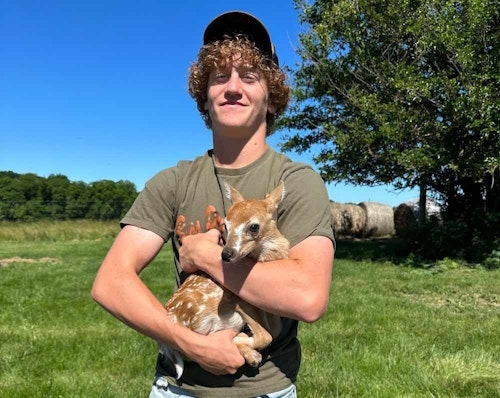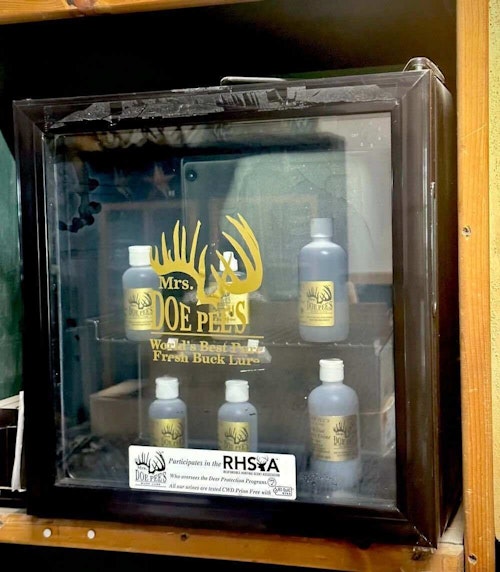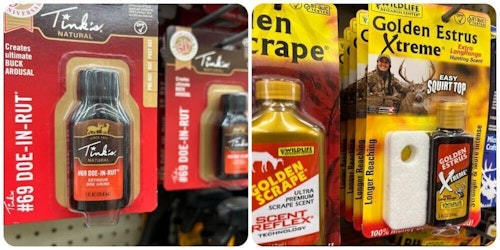It’s a given that large sporting goods retailers dominate many hunting product categories, and I’d bet my favorite hat that deer scents/lures are right up there. Large retailers have mega-buying power and a greater immunity to risks, which is why they can offer dozens of options from all major brands. With that being the case, how in the world can small archery retailers compete?
The short answer is they cannot compete. In fact, trying to keep up with the big retailers by ordering dozens of scents and lures from different manufacturers is a race to the bottom because most small dealers have nowhere near the customer base and demand of large retailers. To have all of that money tied up in deer scent inventory would be very risky for the smaller dealer. However, you can still carve out your slice of the deer scent sales pie and make it worthwhile.
I can think of three potential approaches that small archery dealers can use to find success in this saturated category. Let’s discuss them now.

Approach #1 — One Small Brand
Arguably, the best approach for small dealers is to go with a small brand that has some brand recognition but is not known to the extent of the scent category giants. Initially, this might seem counterintuitive, but let’s dive deeper. Look for a company that offers fresh shipments during the season. I’m talking about scents that are freshly collected, bottled and shipped promptly to dealers that store them in refrigerators or freezers to be sold to end-users. While hunters have success with all different types of scents and lures, the word “fresh” often plucks the right chord with many pro-shop customers, especially those who think deeper and are more detailed.
When my family owned J’s Archery in Antigo, Wisconsin, from 2002-2010, we exclusively sold deer scents from a small company that shipped us fresh product during the hunting season, and we held the bottles in a freezer until our customers bought them from us. Freshness was a huge selling point to our customers, plus we used the scents ourselves and had our own success stories to bolster our sales pitch. It was a small brand that no one really knew because it couldn’t be bought anywhere else in our vicinity, but using it was all it took to make our customers believers. We’d always sell out and have to reorder, and we were by all means a small retail store.

If that doesn’t convince you that a smaller scent company is the way to go, then consider these words from Sam Collora of Mrs. Doe Pee’s Buck Lures located in Salem, Iowa. In addition to their scent business, Sam and his wife, Judi, ran an archery shop for many years, so they understand both sides of the coin very well.
“First of all, freshly collected and bottled deer scent is the real thing,” he said. “It’s what Mother Nature makes; it isn’t a derivative. It’s pure, it’s fresh and has no preservatives. When you add preservatives to a lure, it kills the natural pheromones and makes it less effective. Packaged scents that have been on the shelves for months don’t have the drawing quality of fresh lure. If a customer has any doubts about it because it isn’t a brand they’ve previously heard of, all they have to do is try it. If they’re a legitimate hunter and know how to use it correctly, they’ll have tremendous success and be back for more.
“On top of that, we try really hard not to beat our dealers up and overload them with product and cause them problems. We want to be part of their effort in making money. Our collection times align with that. We don’t have enough lure to supply all of our dealers for the entire season right away. That’s because we don’t collect in April, May and June. We collect during the season. So, we send out a little bit and then a little bit more to keep our dealers supplied with fresh product. We keep shipping it as they need it.”
A smaller brand also harmonizes with the “pro shop feel” that most small dealers are trying to foster. In other words, you’re offering something of a higher standard that hunters can’t typically find while shopping at the corporate giants. Plus, when you call a company such as Mrs. Doe Pee’s, you get to talk with the people behind the brand, not merely customer service reps.
“Most scent companies buy their scent from deer farmers,” Sam’s wife, Judi, explained. “There aren’t very many scent companies that have their own deer herd and also sell scent like we do. When you’re being supplied by another party, you have to trust what they’re telling you. That is not a factor for us. We know exactly what’s in every bottle we ship.”

Approach #2 — One Big Brand
There are a handful of well-known companies that sell bottled deer urine and synthetic versions. Thumb through any major hunting magazines or watch hunting TV, and it won’t take long to identify the major players. Specifically, these are the companies that spend a lot of marketing dollars on things like magazine ads and sponsorships of professional hunters and TV shows. They’re in the hunting community’s eye so much that they have incredible brand recognition.
Identify two or three such brands and then discuss their pricing and programs. If all else is equal, go with the brand that has the best profit-margin potential. Stick with this one brand and don’t get swept up by the cyclone of offerings. Of course, your larger competitors are likely to have that brand, too, but you’re not trying to entice their customers. You’re simply offering your customers — people who are going to buy deer scents no matter where they must go to get them — a solid option while they’re already shopping in your store for other things.
Approach #3 — One Big Brand and One Little Brand
If you have a slightly larger store but aren’t a giant retailer, then this approach could be the best option. It’s as simple as combining the previous two approaches. It keeps things simple, but it offers your customer more. Here is why it’s important.
While some customers welcome insight from a professional (that’s you), it's a given that some don’t want to and won’t ask for advice. They just want to grab something off the shelf, pay for it and be on their way. Scents and lures from a larger company — Code Blue, Tink’s and Wildlife Research Center, to name a few — will immediately catch their eyes, and because you have it on your shelf, they’ll often buy it from you to avoid another stop at a big store that has a confusing number of offerings.
Then, for the more detailed customer who welcomes your input, you can offer the fresh stuff. These customers will typically involve you by asking your opinion on what’s best. This is when you can explain the options and discuss the differences between the packaged product on the shelf and the fresh stuff in the freezer or refrigerator. Your efforts in educating your customers and offering a top-tier product will typically pay off. Even a skeptical customer who tries a fresh product and sees the results will typically become a repeat customer.
Merchandising Tips
One dilemma with small, fresh-scent companies is the product isn’t necessarily visible or doesn’t stand out to customers as they come through the door. So, you’ll have to work a little harder to make the refrigerator or freezer pop out. Ask the scent company for signs and logos. Also, go with a freezer or refrigerator that has a glass door.
If you have a reader-board sign out front, announce when fresh product arrives. Blast it out on your e-mail list and on your social media platforms. Create some buzz so your customers come in asking for it and can find it easily, otherwise, it will likely die on the vine in a tucked-away corner of your shop.
Geographic Location Matters
When considering order quantities, be particularly mindful of your geographic location for three reasons.
- Are whitetails the dominant big game species to hunt in your immediate area? Think: A shop in a small town of a Midwestern or Eastern state will typically have a lot more customers shopping for deer scents than a shop in, say, Sheridan, Wyoming, or Bozeman, Montana, where other big game species such as elk, pronghorn and mule deer are the more primary big game species.
- What is your customer base? If you’re serving a small community, you’ll have some demand, but it will be much smaller than if you’re serving a larger community or several smaller communities.
- Know the scent-usage laws in your state/province. Only sell what’s legal to use.
With that being said, order wisely. Ending the deer season with a bunch of leftover scents and lures on the shelves is detrimental. When you work with a smaller company that is willing to ship multiple times throughout the fall, you can order more conservatively to keep your customers supplied without going too far overboard. It’s a safeguard in and of itself.
Final Thoughts
There is no doubt that the deer scent category is saturated with countless options. Let the larger chain retailers have the hassle of stocking dozens of SKUs. Simplify things by minimizing your offerings. Not only will it make your customer’s shopping experience less daunting, but it will also be far less difficult to annually cycle through product so you’re not left with tons of unsold merchandise following the deer hunting season. Do this, and you can have your little piece of the deer scent sales pie.
Sidebar: Scents and CWD
Deer scent/lure usage varies by state and long has. But, things have become even more stringent as state wildlife agencies address the potential spread of CWD (chronic wasting disease). As part of the Deer Protection Program, the Responsible Hunting Scent Association (RHSA) has created compliance protocols that scent companies must follow — by the way, these meet and exceed state and federal regulations — in order to be certified. I suggest buying only deer scent merchandise from companies that are members of RHSA. To learn more about RHSA and its compliance protocols, visit responsiblescents.com.
Sidebar: Odor Eliminators
Another extremely saturated category related to scents and lures is odor elimination. There are so many companies selling odor-elimination products that it is hard to even name half of them. From ozone machines to odor-eliminating sprays to laundry detergent to hair and body care, there must be hundreds of SKUs on the market.
As with deer scents, don’t become overwhelmed. Choose a reputable brand or two and stick with them. Keep your offerings to a minimum and let the corporate retailers manage the hassle of dozens and dozens of SKUs. Most pro shop customers don’t want an overwhelming selection anyway. They want what you use and believe in.







